Choosing the right laptop for yourself can be confusing with the sheer number of choices available from a massive list of brands. If you go to a physical store, in most cases, the salesperson will sell you what he wants to sell rather than considering your requirements.
Brands market their laptops strongly, with various offers and features. With so many options, it becomes confusing. So, how do you pick the right laptop? Well, there is a methodical process to do so and this article will tell you exactly how to do that.
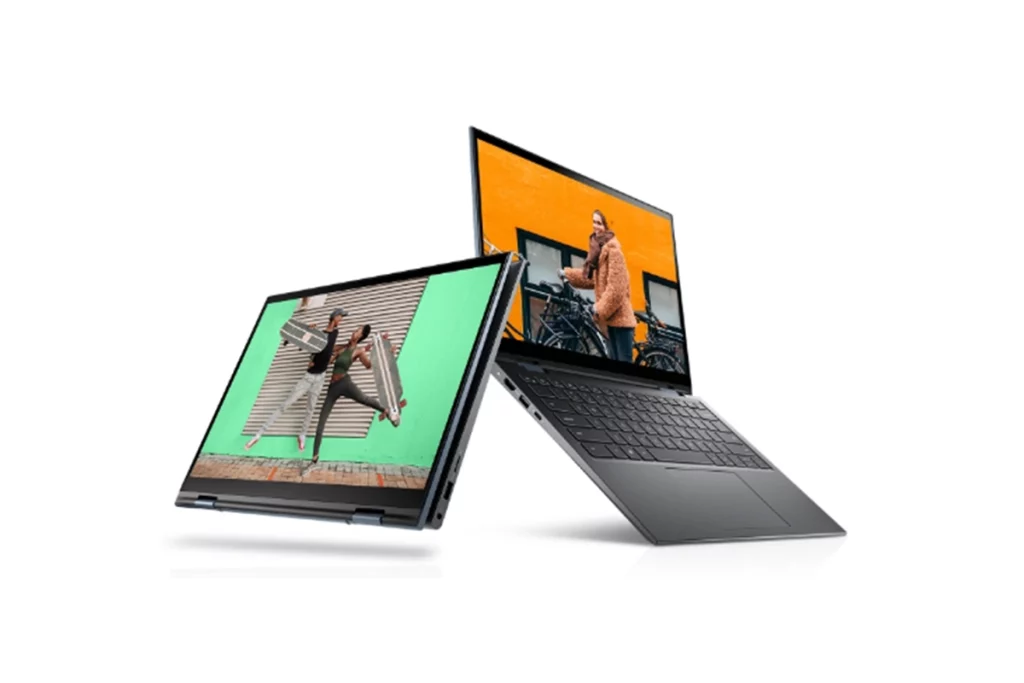
- Buying laptops in India
- How to choose the right laptop
- Determining your primary usage
- Setting the right budget
- Form Factor and Size
- Choosing the right processor for laptop
- Choosing the right graphics for your laptop
- How much RAM and Storage is enough for a laptop?
- Choosing the best display for a laptop
- Ports and Other Features
- Best place to buy a laptop in India
- Conclusion
Buying laptops in India
When compared to markets like the USA or Europe, you get relatively fewer options in India. Especially in the premium and high-end laptop segment. The names can get really confusing since many models will have the same nomenclature but will have different specs, each with a different model number.
This can quickly become a headache for someone who has never bought a laptop before.
Laptop brands in India
Here is a list of brands that you can buy laptops from in India
- Acer
- Asus
- MSI
- Lenovo
- HP
- Samsung
- LG
- Redmi
- Mi
- Apple
- Microsoft
- Dell
Some brands that are available in India but are difficult to get
- Gigabyte
- Razer
How to choose the right laptop
As mentioned earlier, there is a method to choose the best laptop and if you keep in mind certain things like budget, and usage and follow these steps, you will end up choosing the right laptop for yourself.
Determining your primary usage
Budget is usually the first thing people decide but don’t be sold on that. The most important thing is what your primary use case is with your laptop. Are you using it for work, productivity, school or gaming?
Even beyond that know what you will be doing most of the time. If you are into productivity, do you majorly do work like video editing, 3D art rendering or just writing blogs? Understand your primary work as the first step.
You don’t have to limit your use case to something very specific. You can buy a laptop that you need for daily work and still game at night when your work is done. Consider all things that you will be doing with your laptop.
Setting the right budget
Choosing your budget is the second step because you can’t expect to buy a gaming laptop under ₹30,000. If you restrict your budget to that and try to find a gaming laptop, you won’t.
Set a practical budget for your requirements.
Also, many people end up increasing their budgets when they find out they won’t be getting things they might need in their strict budget.
Just to give you an idea, an entry-level gaming laptop starts from ₹50,000 and a good productivity laptop can range from ₹40,000 to ₹1,00,000. Everyday work laptop can go as below as ₹30000 or more.
Form Factor and Size
There was a time when the 15.6-inch laptop was the standard and the only other option was 13-inch notebooks, which didn’t perform very well. Now, there are several options to choose from.
You can buy an ultra-slim laptop or a larger 17.3-inch laptop or get a smaller 14-inch laptop for portability. What has changed is, that all of these options can perform really great and don’t sacrifice much to achieve the smaller form factor.
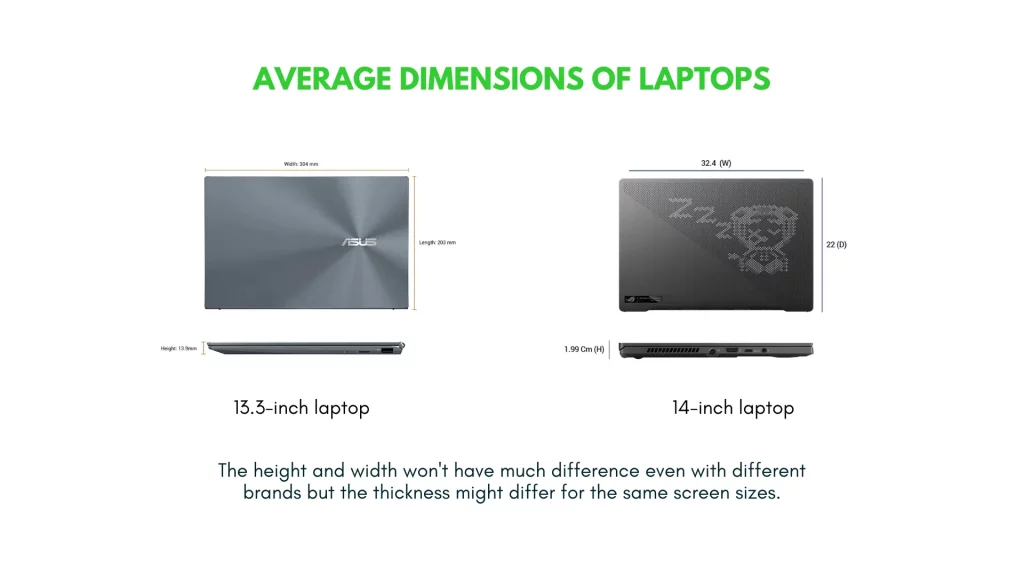
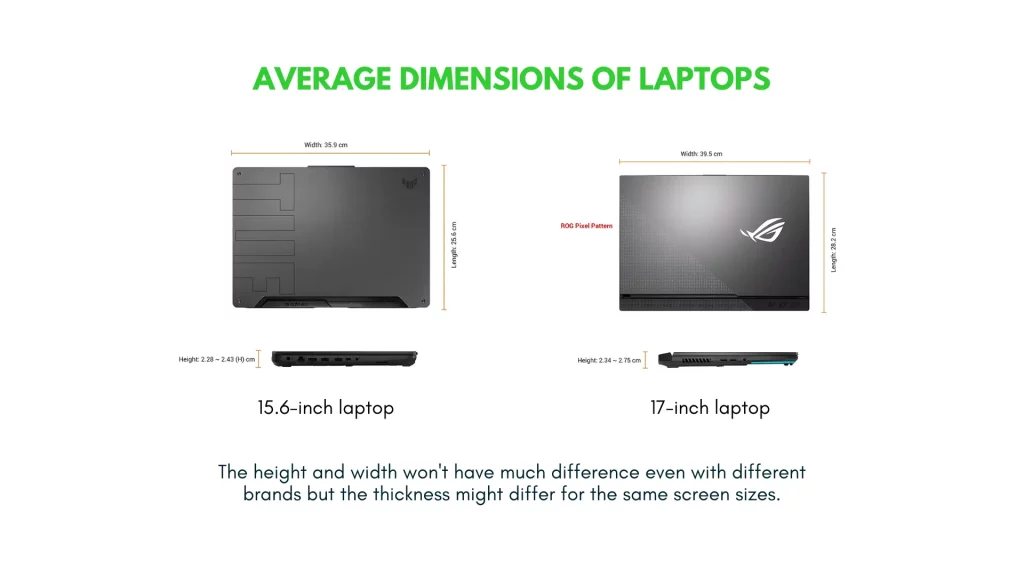
Popular size options
- 13.3-inch
- 14-inch
- 15.6-inch
- 17.3-inch
15.6-inch is the most common and mainstream size, whereas 14-inch is increasingly becoming popular since they do not have to sacrifice performance for the smaller size.
13.3 inch are sought by a few people but there isn’t a lot of options in this size for you to choose from.
Both 14-inch and 13.3-inches laptops are great for portability, and they always weigh less than conventional laptops.
The 17-inch laptop is relatively new to the market and is mostly restricted to gaming laptops. A bigger screen makes quite a difference in the gaming experience, and there is a very limited option available in this size.
Size is not the only thing to consider. Laptops come in various modes like 2-in-1, Touch, Dual Screen and convertible. If you do not have any special requirements, getting a normal laptop is absolutely fine.

If you want touch options, it is better to get a laptop with 2-in-1 or convertible capabilities. It is redundant to have a laptop with a touch screen and no convertible capabilities. (I owned one and I still regret it.)
If you are a heavy multitasker and work on applications like photo editing or illustration, having touch and convertible factors is very useful and practical.
The dual-screen laptop is a unique form factor and is only available from the Asus but a few companies are working on making foldable laptops.
Choosing the right processor for laptop
For processors, you have 2 options. It’s either Intel or AMD. Both are good options to consider and both have their advantages. AMD usually offers better efficiency in terms of power which enhances the laptop’s battery life.
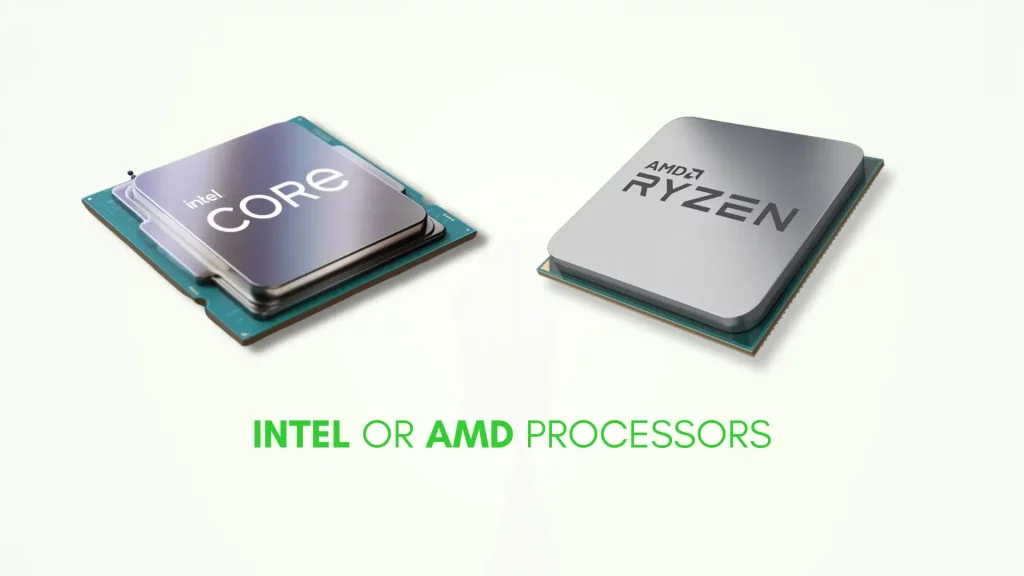
Does clock speed matter in laptops?
It is usually argued that Intel is better for gaming because of its higher clock speeds. If you don’t know what clock speed is – in simple terms, it’s just the speed of your processor. The higher you go, the faster your processor is.
Intel on average has higher clock speeds compared to AMD but higher clock speeds come with their own problems. HEAT! Higher clock speeds generate more heat which might need a better cooling solution in the laptop, making it more expensive.
More heat and a higher clock also affect the battery life negatively and battery life is important for a laptop.
It should be noted that processors with higher clocks don’t always mean it is better. Clock speeds are not the only metric to compare different processors in a laptop. While Intel, on average, gives you high clock speeds, AMD offers more cores in the same price bracket compared to Intel.
For laptops, more than core clock speeds, the amount of cores is more relevant for a general user.
How many cores is enough?
Core counts in today’s laptops can go up to 16 cores, and that is insane for consumer products! Well, do you need 16 cores on your laptop? No. You don’t need more than 6 cores, even for gaming.
If someone tells you that you need to have 8 cores at least in a good laptop, you don’t. Six cores are more than enough for most of the operations you might do on your laptop. Well, it is easy to get 8 cores processor even in budget segments, so from the perspective of value, 8-cores is ideal.
Ultra-budget laptops with 2- cores (found mostly in Chromebooks) can be decent enough for general everyday use like browsing the internet, email tasks, media consumption and some light document work. But going beyond that, for example, intense multitasking or content creation, a dual-core processor laptop may not be ideal.
4-core processors can be good for budget laptops with basic tasks and even some light content creation work.
6-cores are good enough for most users out there. 8-cores are ideal for gaming and above that are good for more intense workloads like Artificial Intelligence, Machine Learning, 3D rendering or 4k video editing.
Now that you understand how many cores you would actually need for your work, laptop processors are infamous for confusing SKUs (processor variant/model). A single generation of processors can have more than 20 variants of processors and it is not easy to understand which is better.
A guide to understanding laptop processors a little better.
Intel processors are broadly classified with a unique suffix. Intel used these suffixes until the 11th gen and this is what it means.
-H (Example: i5-10400H)
These processors are meant for high-performance tasks with 45W of power consumption (not boost TDP). These are meant for gaming, intensive productivity tasks and for power use.
-G7 / -G4 / -G1 (Example: i5-1035G1, i3-115G4)
These processors are used in budget laptops and they have lesser cores and threads. They operate at lower power (15W) to conserve energy and produce less heat. These are good for everyday use laptops where you might need more battery life.
-U (Example: i3-10110U)
These processors are underclocked processors with lower clocks and also lesser core counts. These are mostly used in thin laptops. They are also used in budget laptops but their main purpose is to be used in ultra-thin laptops/notebooks. They too operate at lower power of 15W.
Note: You will also find -HK processors but these are limited to the top-end processors like i9 and you won’t find them in the likes of i5 and i3. They operate at higher TDP and perform slightly better than -H processors.
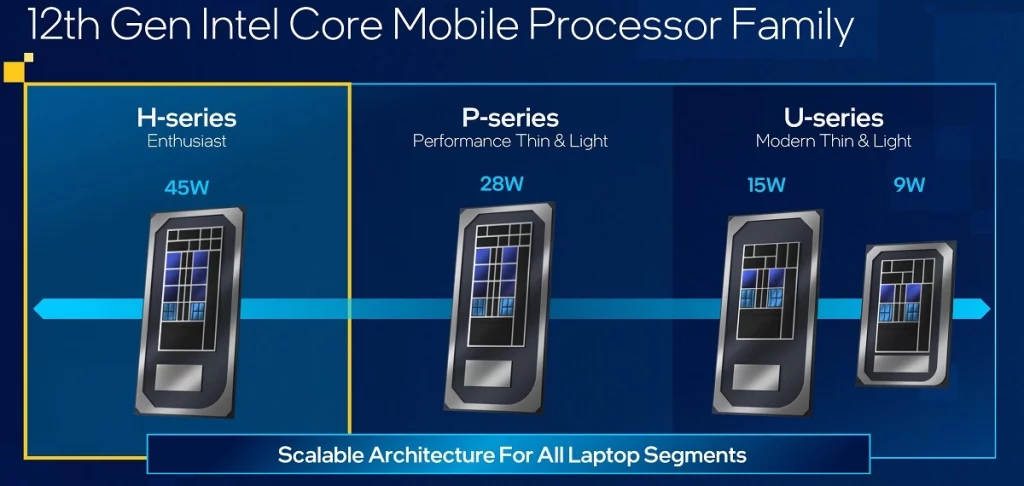
Starting with the 12th gen, Intel has slightly changed the naming scheme.
-H (Example: i7-12800H, i5-12600H)
Things remain the same here. These processors are meant for high-performance with peak power of 95-115W of power consumption (45W base power). These are meant for gaming, intensive productivity tasks and for power users.
-P (Example: i5-1250P, i7-1280p, i3-1220P)
The earlier processors with -G7 / -G4 is basically replaced with these processors. These are much better processors with higher performance. Although they operate at a slightly higher TDP of 28W, they are much better suited for mid-range and budget laptops.
-U (Example: i3-1210U)
These processors are underclocked processors with lower clocks and also lesser core counts. But this time around they are much more powerful and efficient, all thanks to new architecture with a combination of Efficient and Performance cores. They are better for laptops which are thin and of small form factor. They operate at a base TDP of 15W (boost – 55W)
12th-gen processors are game-changing because even the lower-class -U processors can be efficiently used in relatively heavy tasks like video and photo editing without feeling sluggish.
In short, the higher-powered -H or -HK/HX processors are meant for top-class performance in gaming and heavy productive workloads. Whereas the -U and -P are meant for budget and thin laptops which needs to be power efficient.
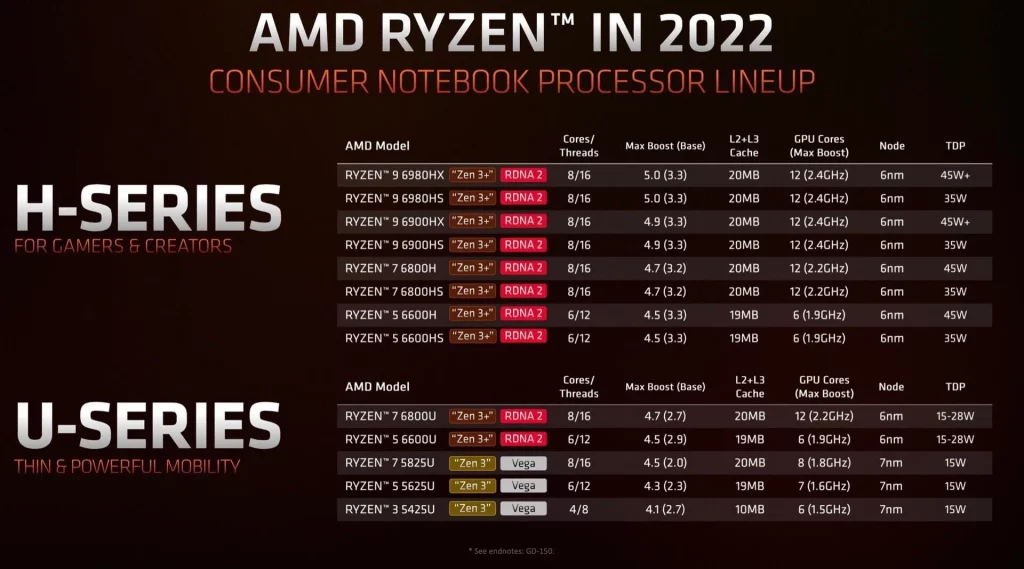
For AMD, the basic concept remains the same with slightly different naming schemes.
-H (Example: Ryzen 5 5600H, Ryzen 7 4800H)
These processors are used in performance laptops with a TDP of 45W. Mostly used in gaming laptops and performance-oriented laptops.
-U (Example: Ryzen 5 3550U, Ryzen 3 5400U)
These are similar to Intel’s -U processors which are used on budget and thin laptops. Unlike Intel, AMD does not cut on the number of cores or threads. It operates at 15 W TDP.
-HS/HX (Example: Ryzen 7 6800HS, Ryzen 9 6900HX)
-HS processors are very similar to -H but with a small difference in power consumption. It is used in thin, performance laptops (like Asus Zephyrus G14) to reduce the amount of heat it generates. Operates at 35W.
-HX processors have higher clocks and are mostly restricted to gaming laptops at the higher end of the spectrum. Operates at 45W.
Choosing the right graphics for your laptop
Choosing a graphics card for your laptop is straightforward and mostly depends on your budget. Right now, the most entry-level laptop comes with GTX 1650. At this point, it is quite old but that is the starting point for gaming laptops.
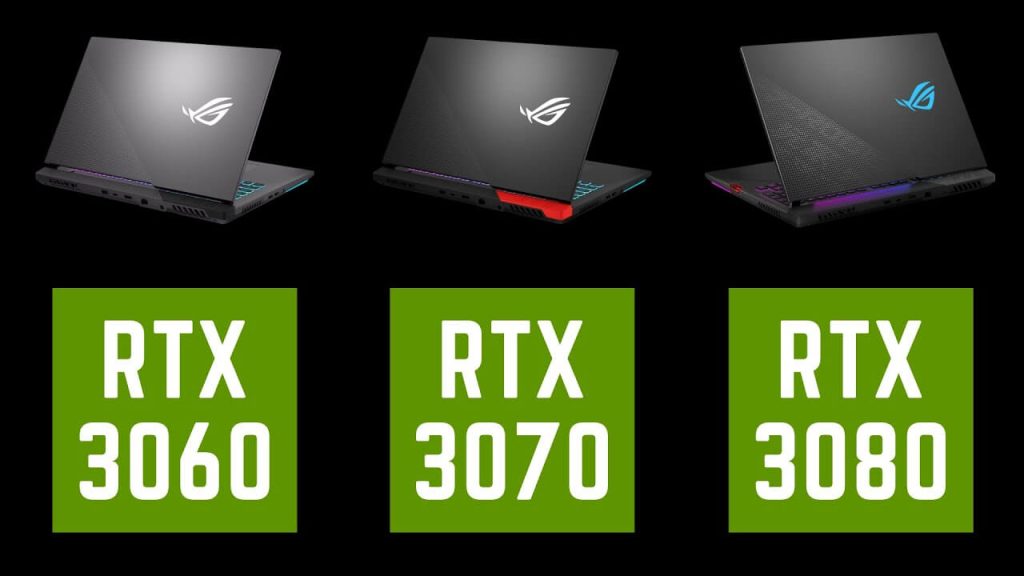
Laptop manufacturers cut down on the TDP (power) of the GPU in their laptops to reduce the cost of laptops. For example, MSI GF63 uses the same RTX 3050 as in Asus TUF models but it costs considerably less. It is because MSI uses RTX 3050 at just 40W and Asus TUF uses the same RTX 3050 at 75W.
This results in performance differences but creates also creates a price difference. This can be helpful in some cases for budget buyers. This information is not explicitly revealed by many manufacturers so make sure to consult reviews and trusted reviewers on YouTube or any other platform.
Another thing to take notice of is the VRAM. 4GB of VRAM is the lowest for any discrete graphics card and many modern games get bottlenecked by the low memory. If you want a truly good experience with gaming, choose graphics with at least 6GB of VRAM. ALthough for light and casual gaming, 4GB of VRAM can be enough depending on the game you choose.
Again just like in the case of processors, you have the option to choose either Nvidia or AMD. In India, Nvidia graphics models are easy to get and are more popular. Up until now, Nvidia has trumped AMD in this regard but both are good options to choose from.
Note: As of 2022, Nvidia takes the cake with its ray-tracing ability and graphics card offering from entry-level budget class to top-performance class. Plus, laptops using Nvidia GPU are more popular in India and there are very few options for laptops with AMD graphics.
How much RAM and Storage is enough for a laptop?
RAM and storage are other important decision which influences the purchase decision for the majority of consumers.
RAM
4GB of RAM is the lowest a modern laptop will have but it is majorly found in laptops below ₹30000 and above that 8GB of DDR4 RAM is the standard.
4GB of RAM is really not enough for multi-tasking on Windows but it can be enough for Chromebooks. On a tight budget, 4GB of RAM can be okay for media consumption, basic tasks like opening up mails, browsing, using MS Office, etc.
8GB of RAM is the standard and most laptops carry this specification. 8GB of RAM is absolutely fine for most standard modern applications and sufficient for multi-tasking.
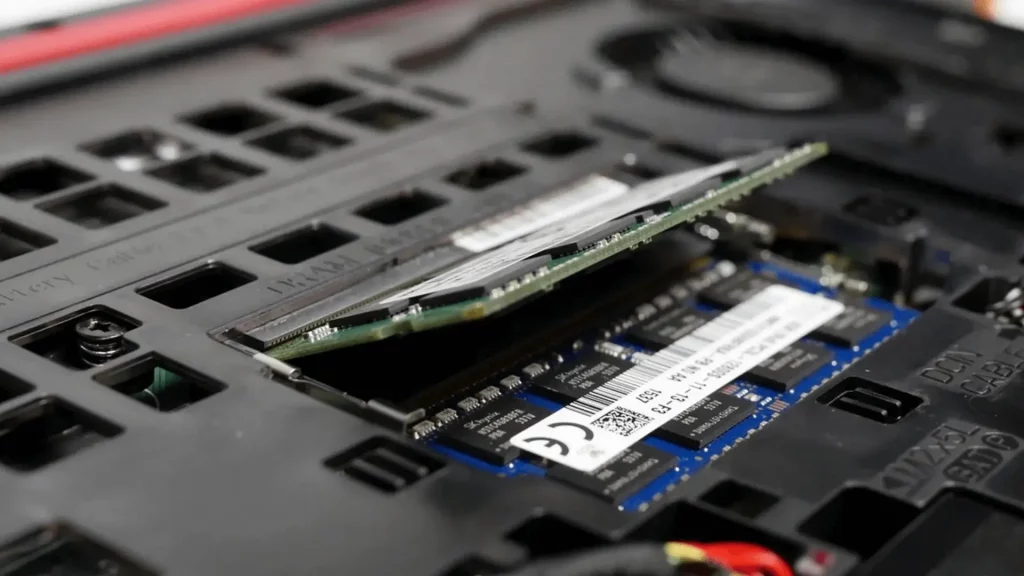
Although you might want to upgrade to 16GB if you are a content creator working on 4k video editing, high-end 3D modelling and competitive gaming.
Another thing to keep in mind about RAM is upgradeability, channel and memory speed. Most of the laptops come in single-channel which means, only one slot is occupied by the RAM stick. It’s not bad to have single-channel RAM but it is not ideal.
Dual-channel memory will give you a boost in performance. This information is not explicitly mentioned by most manufacturers. Do check their official website for detailed specs. Refer to the QnA’s on Amazon and Flipkart or check websites like www.notebookcheck.com for detailed review.
Upgradeability is not an issue in laptops nowadays if the laptop is priced above ₹40000. In most cases, one slot is populated with RAM and the second one is empty which you can use to add another stick of RAM.
But, do check if the upgrade option is available or not because, in some laptops, 2 RAM sticks are soldered in dual-channel mode, leaving no empty slot to upgrade.
Useful note: In many cases, 2 variants with two different RAM specifications are available and the option with more RAM will cost significantly more. If the difference is more than ₹3000, it is better to get a lower RAM specification and add another RAM by yourself. (It costs around ₹2500 for 8GB DDR4 RAM)
Storage
SSD storage has become the standard now and you shouldn’t go with a laptop that has HDD as the primary storage. HDD are super slow and they can’t keep up with the speeds required by modern applications.
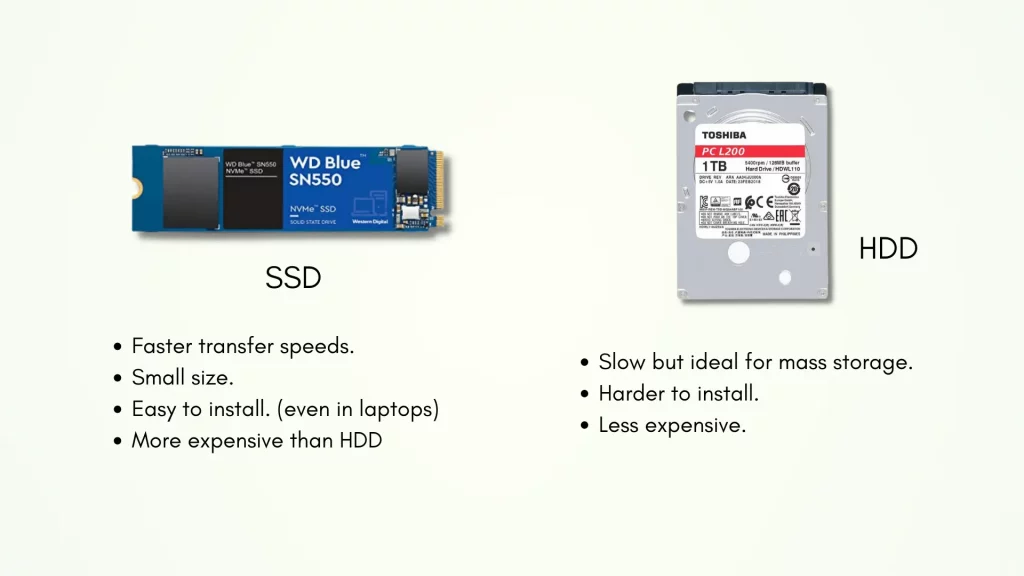
HDD as secondary storage is fine but you want your OS and other primary applications loaded on SSD. Even in budget segments, always opt for SSD instead of HDD even if you get more storage with HDD. You will most probably be able to upgrade your SSD.
If you are a content creator you might need more storage. Ideally, you should opt for a laptop that allows you to use both HDD and SDD. HDD is cheaper and it is perfect for storing large files which you don’t use often.
Storage is completely your personal preference. If you are into normal usage or even gaming, you are fine with 512GB of SSD storage.
Choosing the best display for a laptop
The display is something that remains the same across a wide price range. FHD, 1920*1080 is the standard resolution for most laptops although 1440p displays are coming into the mainstream slowly, but surely.
This is pretty easy to figure out. If you are into tasks like colour grading, professional video and photo editing, you would need a more colour-accurate display. Even if you are a professional graphic designer or content creator, you need a display with better colour accuracy.
Most laptops across budgets come with 45% NTSC colour coverage which may not be ideal. But it is good enough if you are on a budget and can’t stretch your budget for a laptop with a better display as it can get pretty expensive.
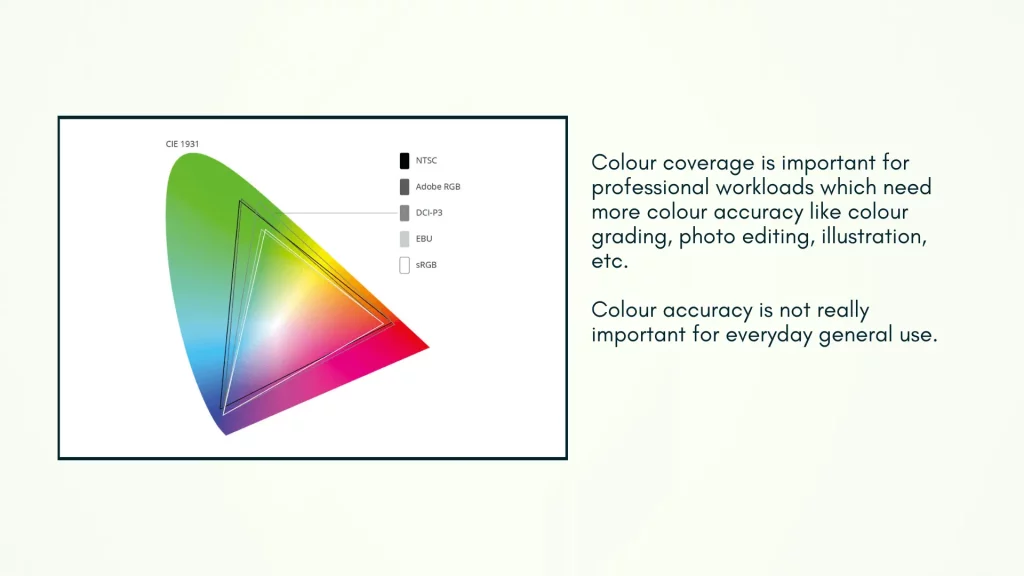
Asus Vivobook OLED model is one that has a really good display on a budget laptop but it sacrifices performance for display. A few other laptops like Mi Notebook Pro, Asus Zenbook, and Lenovo Thinkbook provide 100% sRGB display at a decent price.
Alternatively, you can always use a good external monitor to bypass this problem completely. For an average user, for gaming or media consumption, these displays are fine. If you want the best experience, you can opt for better displays.
1080p resolution for a laptop is good enough since the screen is smaller. You don’t need a 4k or 1440p display in most cases but if your budget can spare it, go for it. Although a 4k display on a laptop is overkill. 1440p is a nice balance for gaming and content creation if you have a GPU capable of running games at 1440p.
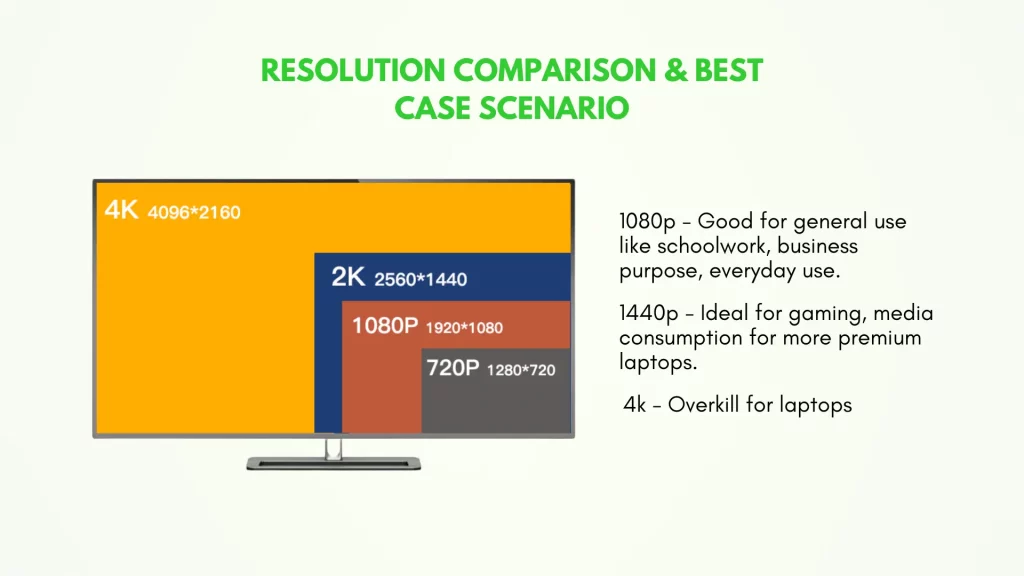
The refresh rate of 144Hz is plenty fast and the best balance between price and performance. 265Hz might seem overkill unless you are into competitive e-sports titles. But consider your budget before jumping in to buy a 265Hz display laptop.
Please note that you won’t find a 144Hz refresh rate under tight budgets below ₹30000. 60Hz is the standard in that segment.
In short, for professional purposes keep the display performance in the forefront or else settle for a standard display if it crosses your budget.
Ports and Other Features
The number of ports a laptop is an important feature which many miss while buying a laptop. A number of ports are pretty much the same in every laptop. Type-C port has become a mainstay feature in most laptops even on the budget.
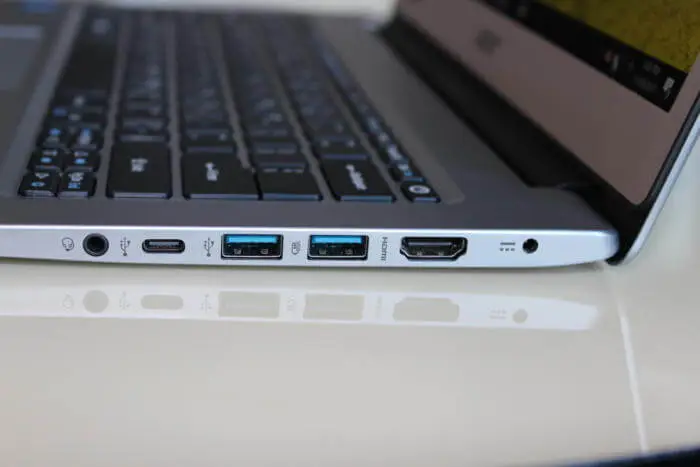
It is favourable to have laptops with at least 2 x USB 3.0 Type-A ports and one 1 USB Type-C port. Other than that you might get more ports with USB 2.0 (usually just one). Some laptops will have 2 Type-C ports which are great if you work with a lot of data (content creators, photo editors).
A MicroSD reader is an added benefit to have if you use memory sticks like those in cameras.
Best place to buy a laptop in India
Buying a laptop in physical stores is good in a way if you want a safer route but it often costs more than buying it online. Also, physical stores for the brands are not available in every city.
They also have fewer options available in the store and the salesperson will definitely try to sell the laptop they want rather than what you want. But you can test the laptop physically before buying it. Alternatively, you can visit Reliance Digital or Croma but the problems are similar there too.
The most convenient place to buy a laptop from is Amazon or Flipkart. Personally, I find Flipkart better for laptops as the UI is cleaner and you get more relevant results. Plus, Flipkart seems to have more laptop options.

Well, in the end, it depends on your preference and comfort. Reliance Digital and Croma are good for both online and offline options. Flipkart and Amazon are the best for buying them online.
Conclusion
Always avoid the mistake of fixing a budget first and then searching for laptops in that category. You might not choose the right laptop for your usage.
Understand your requirements for a laptop and then set a realistic budget. You can’t expect a gaming laptop under ₹40000.
There will be several variants under the same series of a laptop, so read the specifications carefully to avoid buying something you don’t want or need.
Choosing a laptop can be overwhelming with so many choices out there. But, with a proper process and understanding of the specifications, you can definitely make the right choice which you can get a lot of value out of.
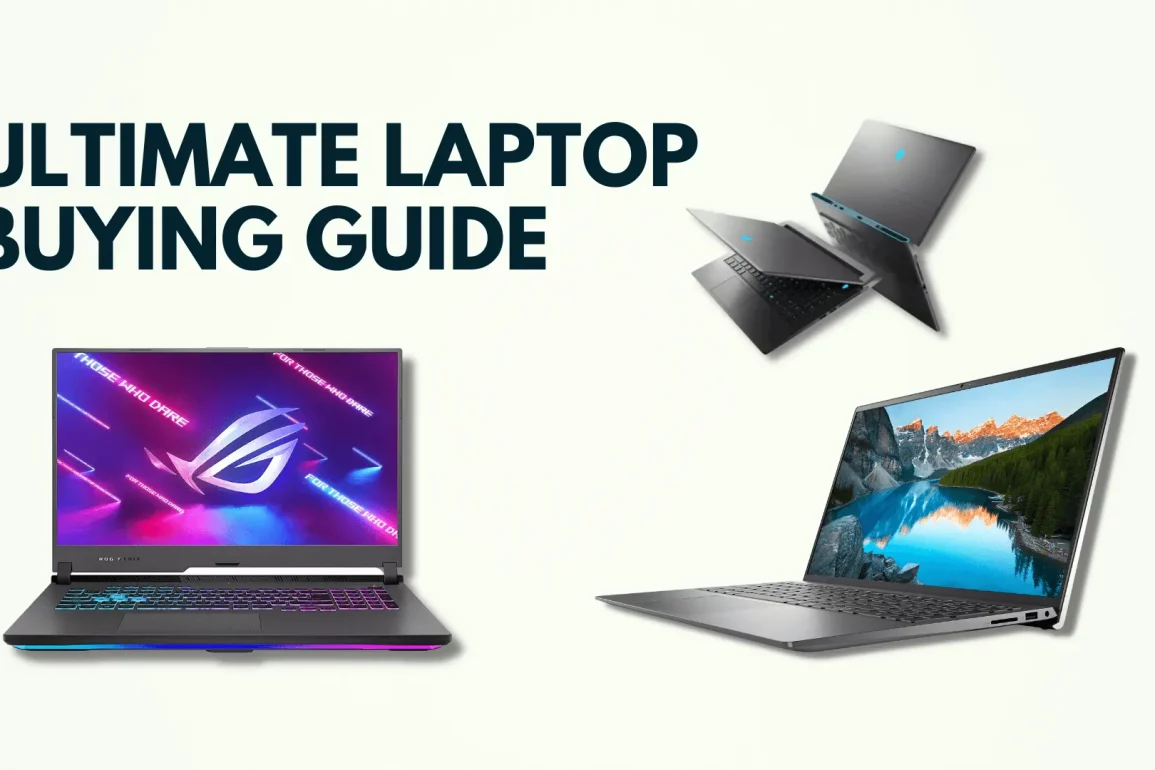
Leave a Reply
You must be logged in to post a comment.